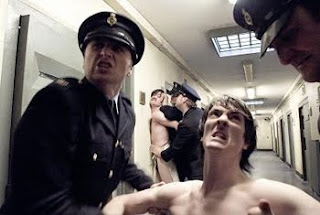 2010 was mostly a year of disappointments even though great filmmakers like Christopher Nolan, Darren Aronofsky and Martin Scorsese delivered fantastic movies. There are still movies that I haven’t seen that might make the cut (like “True Grit”, “The King’s Speech” or “127 Hours”) but, as of today, here’s my Top Ten of the year in descending order:
2010 was mostly a year of disappointments even though great filmmakers like Christopher Nolan, Darren Aronofsky and Martin Scorsese delivered fantastic movies. There are still movies that I haven’t seen that might make the cut (like “True Grit”, “The King’s Speech” or “127 Hours”) but, as of today, here’s my Top Ten of the year in descending order:10. - Exit through the Gift Shop: This documentary about street art is unique in how the filmmaker suddenly becomes the subject of the piece. Is this real or is it a hoax orchestrated by the brilliant British artist Banksy to force us to look closer into the real value of art? In a way it doesn’t matter since it is a compelling and provocative work in itself.
9. - Shutter Island: This was a great year for Leonardo DiCaprio, having made two movies worthy of the Top Ten. In his fourth venture working with Martin Scorsese he delivers a very strong performance in the atmospheric thriller “Shutter Island”. The film grabbed me from the start with its quiet dread creeping into the story and a final twist that gives it an extra layer of tragedy.
8. - Carlos: This movie is epic in every way. Spoken in more than five languages, filmed in several countries and spanning many years, it depicts the life of Illich Ramirez Sanchez (brilliantly portrayed by Edgar Ramirez), one of the most wanted terrorists during the seventies. There are currently three versions of the film (I saw the longest cut of 5 and a half hours, which may be a long time to spend in a theater but more than worth it since there isn’t a dull minute to be found).
7. - Machete: Few movies are more fun to enjoy with a packed theater than Robert Rodriguez’s “Machete”, an absolutely outrageous piece of “mexploitation”. The movie was originally a fake trailer showing before Rodriguez’s “Planet Terror” but became so popular that it was enhanced for feature length with one of the most intriguing casts in recent years. Here’s one of the most entertaining movies of the year.
6. - Toy Story 3: It took 11 years for the toys to return to the big screen but the guys at Pixar once again prove that no one is better at making sophisticated and mature family films (maybe Studio Ghibli is their only rival). “Toy Story 3” is a fitting end for the trilogy and another wonderful movie from Pixar, whose last four movies have been amazing.
5. - The Girl with the Dragon Tattoo: Next year we’ll get the David Fincher-directed remake of this movie, but I don’t think it will surpass this Swedish adaptation of the international bestseller. The biggest triumph of this absorbing thriller is presenting us with a heroine that completely grabs our attention (actress Noomi Rapace is amazing on the role). There are another two installments on the so-called Millenium Trilogy but this one is the best.
4. - The Social Network: I was skeptical of this project from the beginning since I’ve never liked Facebook very much. I have to admit, however, that Fincher did an amazing job directing this story and the performances are great (hell, even Justin Timberlake shines). From the beginning I was completely enthralled in this corporate story of betrayal. “The Social Network” is a movie for our times.
3. - Scott Pilgrim vs. the World: I’ve seen this movie more than 10 times and I’ve enjoyed it immensely every single time. The film is incredibly creative and fun (it also is very geeky, which might explain its poor box-office performance). Directed by Edgar Wright (of “Shaun of the Dead” and “Hot Fuzz” fame), “Scott Pilgrim” is a fantastic achievement destined to become a cult classic.
2. - Black Swan: Here’s another Darren Aronofsky descent into madness. “Black Swan” is a brilliant story of obsession that features one of the strongest performances of the year (Natalie Portman will surely win the Academy Award for best actress). The film is a nightmare fetish set in the ballet world. This movie stands proudly next to “Pi”, “Requiem for a Dream” and “The Fountain”, Aronofsky’s other masterpieces.
1. - Inception: Christopher Nolan is one of the few filmmakers who is able to marry complex and intelligent stories with commercial appeal. “Inception” is a huge movie with ambitious ideas that had us discussing it for months. Is the whole movie a dream? In a way it’s a distillation of different genres and the dreams within the movies. This is yet another provocative work from Nolan and the cleverest piece of entertainment of 2010.



















